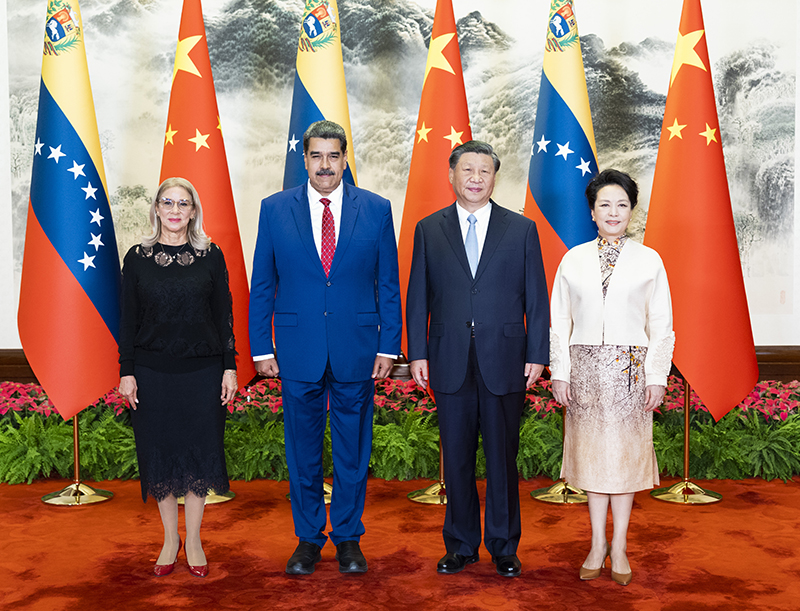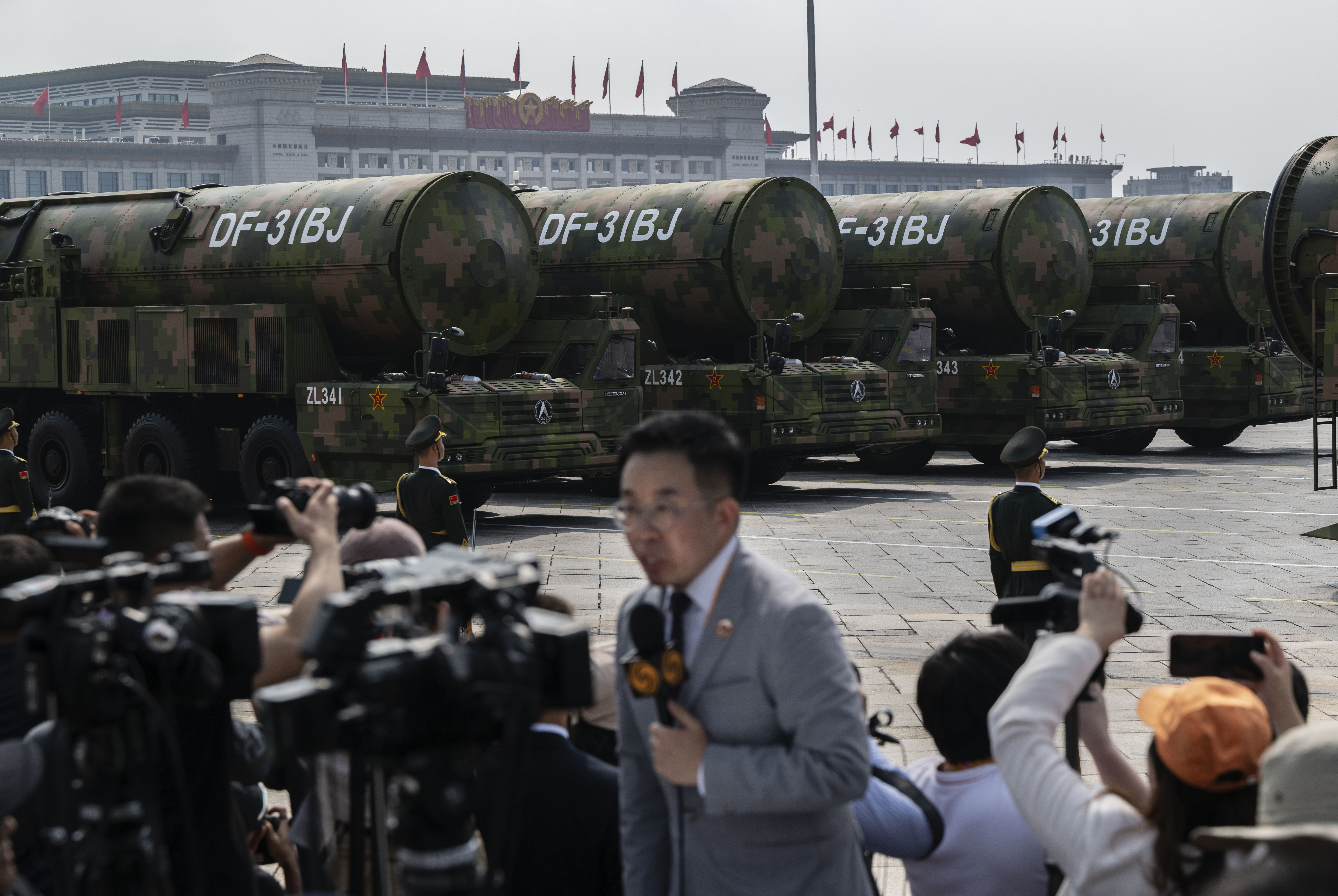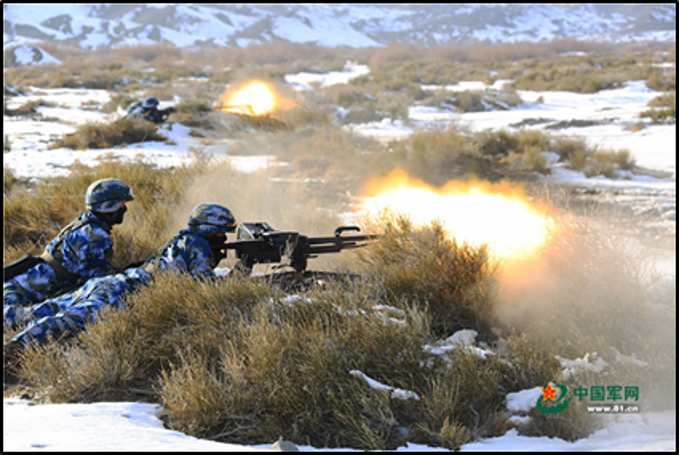
New Wine Into New Wineskins: The Evolving Role of the PLA Navy Marine Corps in Amphibious Warfare and Other Mission Areas
New Wine Into New Wineskins: The Evolving Role of the PLA Navy Marine Corps in Amphibious Warfare and Other Mission Areas
Editor’s Note: In February 2019, China Brief presented an article in two parts by Dennis J. Blasko and Roderick Lee, which profiled order-of-battle expansion and organizational reforms in the PLA Navy Marine Corps (The Chinese Navy’s Marine Corps, Part 1: Expansion and Reorganization and The Chinese Navy’s Marine Corps, Part 2: Chain-of-Command Reforms and Evolving Training). Here, China Brief presents another perspective that discusses the evolving roles for the PLAN Marine Corps—in terms of both amphibious operations alongside the PLA Army, as well as new missions in other environments.
Introduction: The PLAN Marine Corps and the Amphibious Role of the PLA Army
Historically, the Marine Corps was not a branch greatly valued by the People’s Liberation Army Navy (PLAN). The explanation for this had much to do with the PLA’s mission priorities: the PLA has looked to the Taiwan Strait as its main focus area for amphibious warfare, and the PLA Army (PLAA) has traditionally held the primary role in this functional area, with the PLAN Marine Corps (PLANMC) operating in a secondary role.
The former Nanjing Military Region—since reorganized as the Eastern Theater Command (China Brief, February 4, 2016)—has amphibious mechanized units that were subordinate to the PLAA 1st and 73rd Group Armies (now reorganized as the 72nd and 73rd Group Armies, respectively) (China Military, December 2, 2018). The amphibious mechanized units of the PLA Army feature heavier firepower and greater mobility than the PLAN Marine Corps (which originally consisted of only two brigades, the 1st and 164th, both subordinate to the South Sea Fleet). The PLAA amphibious forces focused on “big island” targets: these “big island” targets obviously included Taiwan, the PLA’s top priority scenario for resources and contingency planning. By contrast, the PLANMC was oriented largely towards the defense of islands or reefs in the South China and East China Seas.
As the PLAN has become increasingly stronger in recent years, its efforts to field greater numbers of modern warships—and the deployments and training of these ships—have attracted ever-greater attention. In line with the expansion of its parent service, the PLAN Marine Corps has also grown, in terms of both numbers and missions, to align with China’s growing overseas interests. The two original brigades of the Marine Corps have been augmented in recent years by six more—four combined arms brigades, a special operations brigade, and elements of a shipborne helicopter aviation brigade—based in multiple locations along the length of China’s coastline (China Brief, February 1, 2019).
Only in recent years has the PLA as a larger institution started to rethink the value and use of the Marine Corps—a change resulting from the PLAN’s improvements in capability, and China’s growing national power and increasing overseas interests. Recent training exercises provide some indication of likely future missions for the PLAN’s larger and more capable Marine Corps branch.
Training Exercises of the PLAN Marine Corps
Following from the most recent military reforms initiated in 2016, the PLAN Marine Corps has been engaged in training exercises distinct from those in the past. For example, in early 2016 the PLAN Marine Corps sent troops to conduct “cross-region long-distance mobility training” in the cold weather desert environment of Korla (central Xinjiang). In this exercise, the deployed troops were referred to as “South Sea Dragons” (南海蛟龙, Nanhai Jiaolong)—thereby possibly identifying them as the PLANMC special operations force (SOF) brigade based on Hainan Island, which was converted from a former PLAN Jiaolong naval commando unit. [1] Per press accounts, these troops conducted field maneuvers against a garrison of “Tian Mountain crack troops” (天山雄师, Tian Shan xiongshi) who acted as the opposing force during the exercise (China Army, February 16, 2016).
In March 2018, the PLANMC held an exercise called “Ten Thousand Men and One Thousand Vehicles” (萬人千車, Wan Ren Qian Che) which simulated in a realistic way a cross-region projection of full-strength marine units by air to destinations in Yunnan and Shandong Provinces. State media described these and other exercises as part of normalizing “all-environment training, all-environment employment” (全域訓, 全域用 / quan yu xun, quan yu yong) for the Marine Corps, so that its “footprints would traverse high-latitude cold regions, gravel deserts, plateaus, and jungles” (China Military, March 16, 2018.
These exercises were meant to underscore that the PLAN Marine Corps will be tasked with a range of operations beyond amphibious warfare. Training in different forms of terrain and climate conditions is intended to make the PLANMC acquire capabilities similar to those of the expeditionary forces of the U.S. Marine Corps—which through its history has deployed and fought in a range of locations, from the extremely cold Korean Peninsula to the desert environments of the Middle East. Such training also signals that the PLAN Marine Corps will be the vanguard defender of China’s overseas interests, and its involvement in cross-region mobility exercises is aimed at turning it into a rapid reaction force with a variety of transportation platforms at its disposal.
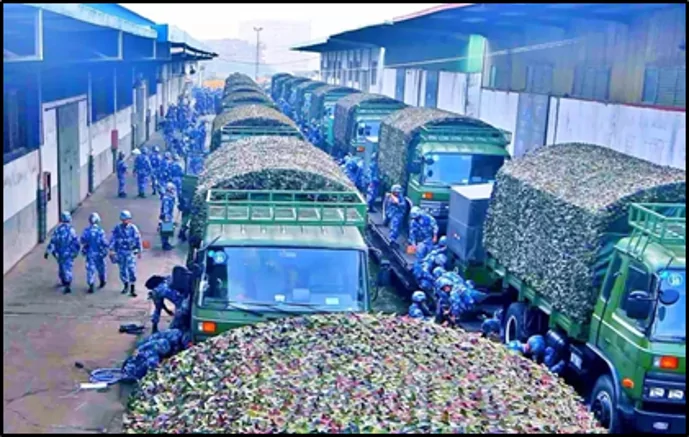
The Focus on Modularized, Combined Arms Units
The PLAN Marine Corps is moving towards the goal of developing highly modularized marine brigades or battalions. In this way the marines can not only be integrated into theater commands’ command systems, but will also be able to operate semi-independently in executing amphibious landing missions—so that PLA Army combined arms brigades landing later may take over follow-on missions seamlessly. The goal is to get the marines prepared for expeditionary missions in the future. Given the fact that China’s future overseas bases—the first of which has been established in Djibouti (China Brief, July 21, 2017; China Brief, March 22, 2019)—will not have the kind of fire and logistics support from theater commands as their counterparts back at home, troops deployed to those bases must be able to fight independently (People Daily, August 2, 2017). The key is in the modularization and organic combined arms capabilities of the forces involved: such units can provide better protection to overseas bases, contribute to regional security, and present a force with more deterrent power.
The organization of the PLAN Marine Corps has been greatly changed, with more emphasis on developing modularized and combined arms formations, and enhancing brigade- and battalion-level units’ capabilities to operate independently (People Daily, February 11, 2018). Meanwhile, the PLANMC, in order to acquire greater air power and airlift capabilities, has been actively developing its own pilots while introducing into service transport and strike helicopters suitable for amphibious warfare (China Military, December 10, 2017). Therefore, in terms of combat capabilities, the PLAN Marine Corps is also getting ready for a greater role in expeditionary missions. Its tasks in the future will include not only amphibious landing on reefs and islands, but also projecting forces using larger amphibious ships newly developed by the PLAN. In this sense, it is developing amphibious capabilities parallel to those traditionally exercised by the PLA Army.
Evolutions in Amphibious Warfare Doctrine Affecting the PLANMC and PLAA
Amphibious warfare refers to projection of forces from naval ships onto a hostile shore or a target landing beach. The PLA’s amphibious warfare doctrine traditionally focused on landing operations of a considerable scale, but it has shifted in recent years to adopt amphibious operations concepts copied from the United States, which include projection of power in the form of non-combat military operations, and the deployment of marines overseas (Xinhua, July 9, 2018). The challenge is for the PLAN Marine Corps to move step-by-step towards the goal of becoming a more effective expeditionary force.
As far as amphibious warfare is concerned, at first glance the PLAN Marine Corps and the PLA Army’s amphibious mechanized troops appear to be tasked with the same missions. However, in practice these forces are different in many ways. One major difference is that marines will have to go with PLAN warships to provide protection in an area of responsibility much larger than that of amphibious mechanized troops of the army. In line with the strategic requirements of “offshore waters defense” (近海防御, jinhai fangyu) and “open seas protection” (远海护卫, yuanhai huwei), the PLAN will gradually shift its focus from “offshore waters defense” to a combination of “offshore waters defense” with “open seas protection”—and it will therefore need to build a combined, multi-functional, and efficient marine combat force structure, including the PLAN Marine Corps.
Moreover, marines execute tactical missions with strategic significance—not only clearing the way for ground troops that land later, but also creating advantageous conditions for naval forces to gain control of the sea. With high mobility and striking power, marine infantry forces are assigned the task of conducting various kinds of raids at sea and on land, as well as special amphibious landing operations. They are thus different from the amphibious mechanized troops employed by the PLA Army.
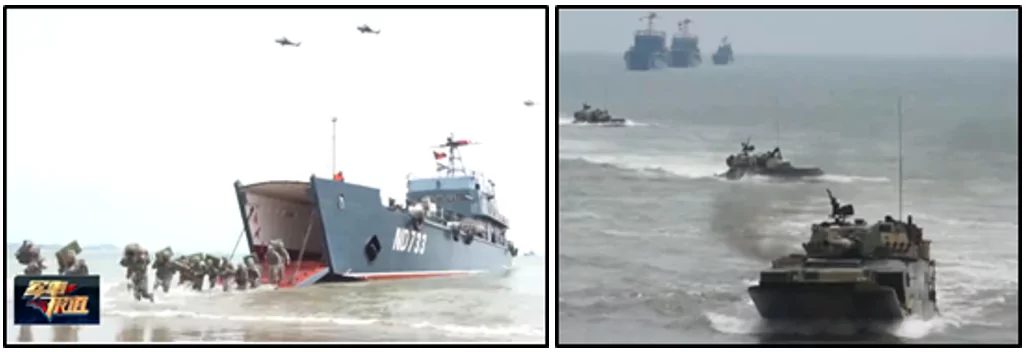
Even after recent military reforms, the PLAA 71st, 72nd, 73rd and 74th Group Armies still maintain their amphibious mechanized units (China Military, December 2, 2018; China Military, May 17, 2019). Based on observed amphibious landing training exercises, we can see that the PLA Army will still play the main role in potential landing operations against Taiwan. The PLAN Marine Corps, therefore, may play a different role and have different uses in the future. It will deploy from large amphibious ships to project forces; take advantage of high-speed mobility offered by helicopters and air-cushioned landing craft; and, in the form of combined arms battalions, conduct reconnaissance, small-scale raids, infiltrations, and special operations attacks. In terms of island landing operations, the PLAN Marine Corps will likely play the role of a first attack force that operates inside hostile or contested territory; while the amphibious mechanized combined arms brigades of the PLAA will provide the main external attack force (Sina Military, February 6, 2017).
The PLA’s amphibious landing operations concepts are still focused primarily on “attack on main targets” (重点打击, zhongdian daji), “three-dimensional landing” (立体登陆, liti denglu), and “deep strike” (纵深突击, zongshen) (People Daily, September 17, 2016). The focus is on landing from multiple sites and launching mobile raids—and this is a mode of operations that takes advantage of high-speed transports to conduct raids on land targets by highly-mobile forces, in all terrains and at multiple sites (China Military, February 28, 2018). In PLA concepts for amphibious warfare, marines can play a key role in occupying vital sites and establishing beachheads, setting the stage for heavier forces to achieve the goal of breaking into hostile territory in depth.
Conclusion
In summary, the post-reform PLAN Marine Corps is changing its operational paradigm to one of small-scale combined arms special operations. With the induction of new amphibious ships into service, the PLAN Marine Corps is in the process of developing into an expeditionary force. In practice, the PLAN Marine Corps may adopt an amphibious landing mode different from what has been seen before: one that will count on large amphibious ships to project forces; take advantage of the high-speed capabilities of helicopters and air-cushioned landing craft; incorporate the reconnaissance capabilities and strike power of UAVs; and conduct small-scale raids, infiltrations, and special operations attacks on multiple targets (China Military, October 30, 2018).
The PLAN Marine Corps is currently moving toward modularization and combined arms formations, characterized by more flexible operational structures. In terms of PLANMC changes in operational concepts, traditional tactics and fighting methods are no longer applicable. The new force structure and operational concepts of the PLAN Marine Corps will offer it a greater role in protecting Chinese interests abroad, in a variety of terrain types and climate conditions—as well as making it a valuable counterpart to PLA Army amphibious forces in island landing scenarios involving the South China Sea or Taiwan.
Dr. Ying-Yu Lin is an Adjunct Assistant Professor at the Institute of Strategic and International Affairs, located at National Chung Cheng University in Chiayi, Taiwan. He is also a Research Fellow with the Association of Strategic Foresight. Dr. Lin received his Ph.D from the Graduate Institute of International Affairs and Strategic Studies, Tamkang University. His research interests include the development of PLA capabilities, and cyber security issues.
Notes
[1] For discussion of this specific point, as well as further information about changes to the PLANMC order-of-battle, see: Dennis J. Blasko and Roderick Lee, “The Chinese Navy’s Marine Corps, Part 1: Expansion and Reorganization,” China Brief, February 1, 2019. http://jamestown.org/program/the-chinese-navys-marine-corps-part-1-expansion-and-reorganization/
